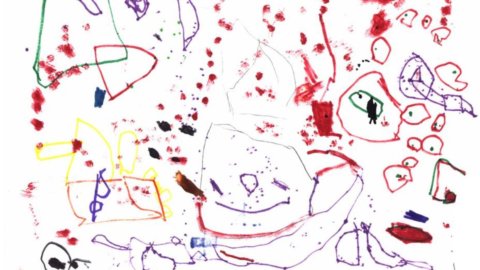She was baptized napkin art, curious definition that underlines the origin. In fact, it seems that an English father, every time he took his family to a restaurant, to make his son feel good, gave them felt-tip pens and paper napkins so that the child could enjoy scribbling. But the preciousness lies in the fact that the father kept all the drawings. Subsequently, he persuaded his wife Mary Higgins that she had an art gallery to organize an exhibition entitled "The art of the napkin“. The invitation to the exhibition – it was also Christmas – consisted of a printout of scribbles and was a success. Which she also thought of making a limited number of lithographs, even large ones, which were put on sale for between 7.500 and 22.500 lire at the time.
Exhibitions followed everywhere – from Montreal to Munich, from Toledo to Tokyo and Milan (1973). Important companies such as Mercedes-Benz were also involved, which promoted more than one exhibition, but also international banks used these scribbles as marketing to customers. But this way was not limited to England, crossing the borders, Portuguese children illustrated a guide to Lisbon, other Americans, published volumes of illustration, in Florence on the initiative of a teacher, told their drawings inspired by the drama of the flood '66. In 1963 Prince Ranieri of Monaco began this particular artistic production of stamps with the issue of a series of six values, dedicated to the Charter of the Rights of the Child formulated by the United Nations.
No artistic expression compares to children's art in terms of spontaneity, of course children express more different moods. Children's art is an art as old as the world! Let's not forget that the great artist has always been an individual capable of looking at reality with the same eyes as a child. “Throughout my life I have always tried to paint like a child” said Picasso. Not to mention Joan Mirò, March Chagall, or Jakson Pollock, the master of the “dripping“, the technique that consists in randomly dripping abundant quantities of color onto huge canvases placed on the floor, obtaining compositions that are completely similar to children's “scribbles”… even if they are authentic masterpieces!
One of the first figuratives who considered figurative images of children as an art form was Thomas Robert Ablett, a schoolteacher from Yorkshire, England. Later, at the end of the century, a Czechoslovak named Franz Cizek changed the situation by deciding the very future of children's art. In practice, Cizek's teaching method is a sort of invitation addressed to the child. To understand it, just imagine for a moment transforming yourself into a three-year-old boy or girl and letting your imagination run wild with a crayon, signs that slowly become expressions and strong amusement.
A child's drawing is his story, his confession, his poetry; but it is also the thought of him, his x-ray of soul. It doesn't matter that the horse has two legs, after all isn't that how everyone sees it in profile?
Now the art of the napkin finds its maximum expression in Illustration for children. While the children will always scribble with markers and recycled sheets of paper, at home, at school, at the doctor's, in the dedicated area”kids” of fast food restaurants, supermarkets and bookstores. And who…skilled…in toy tablets.





